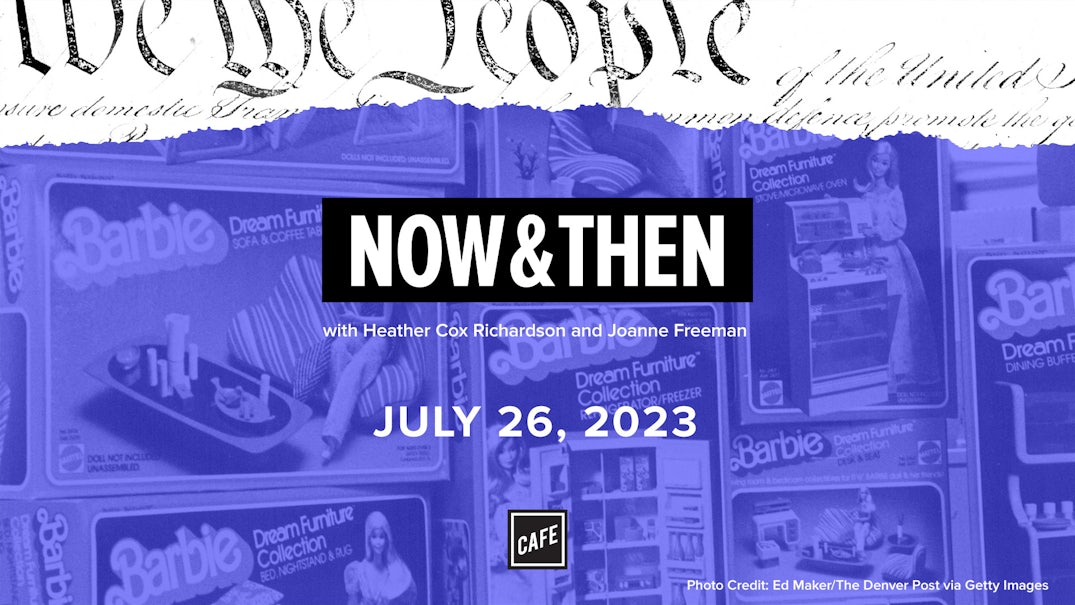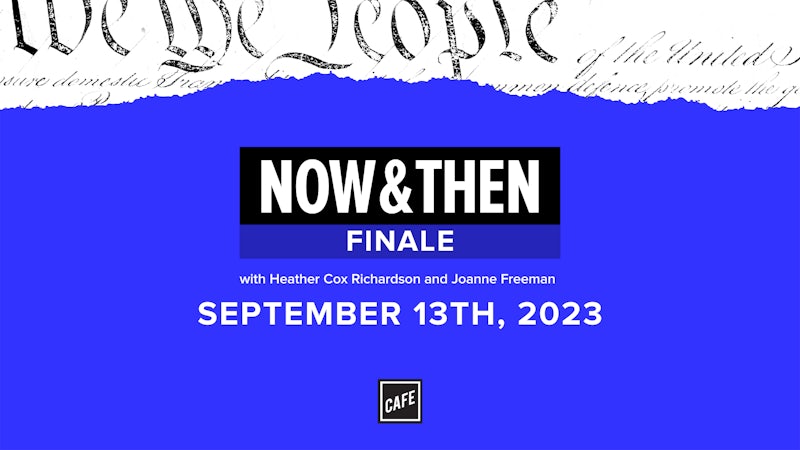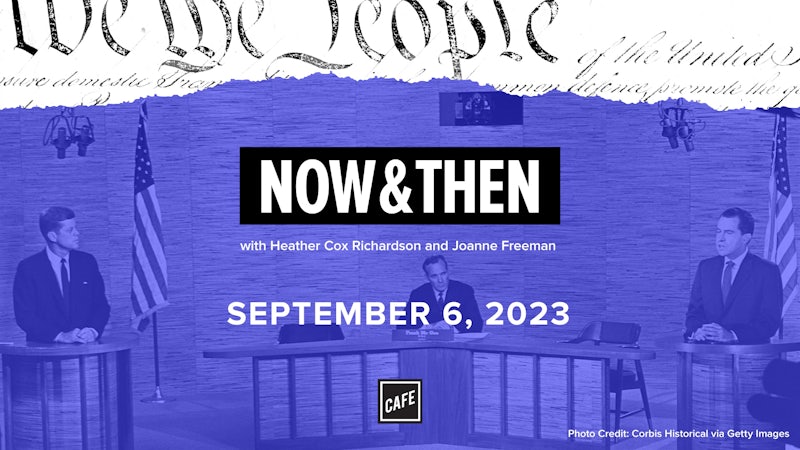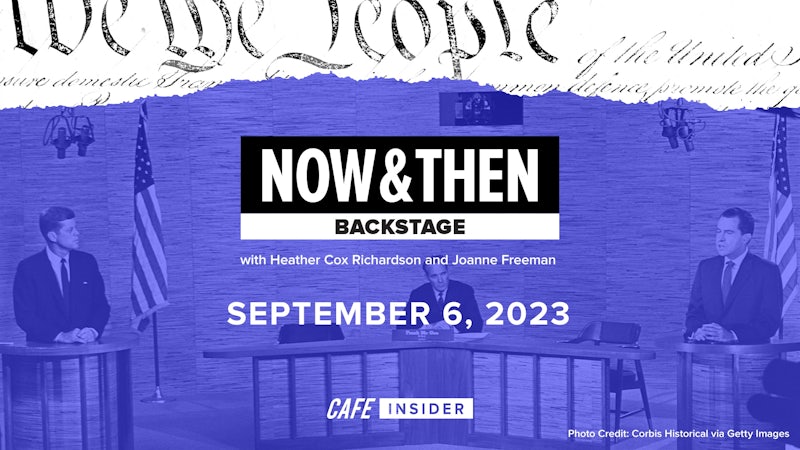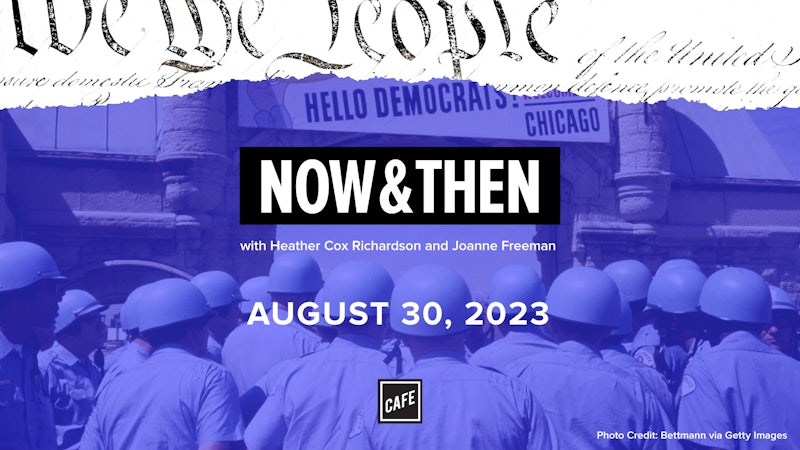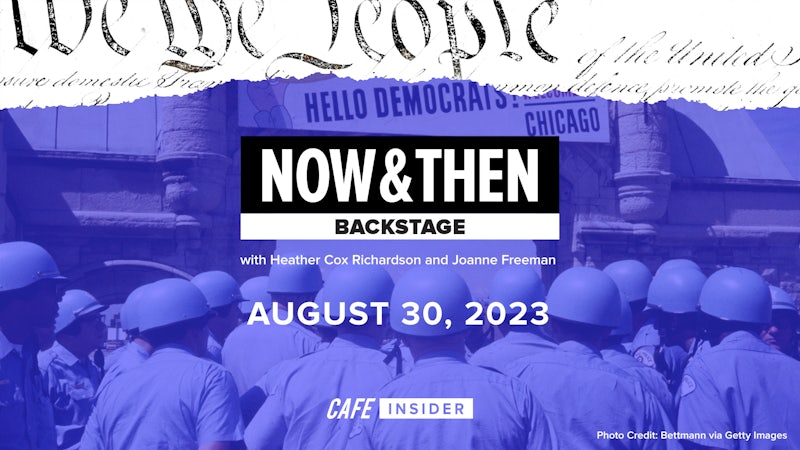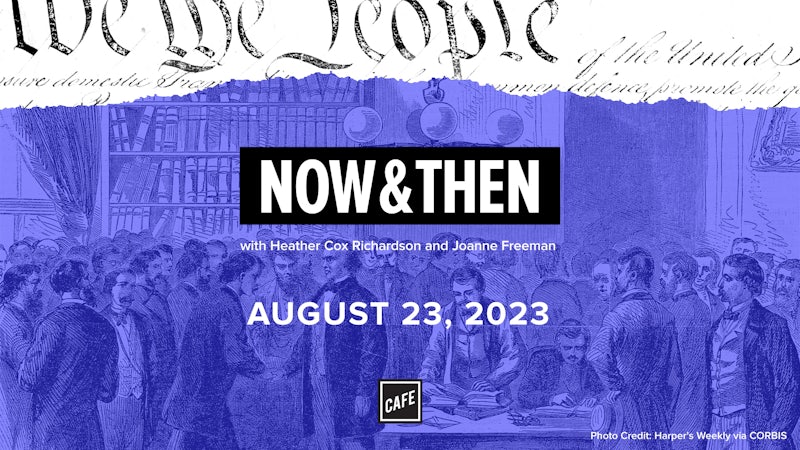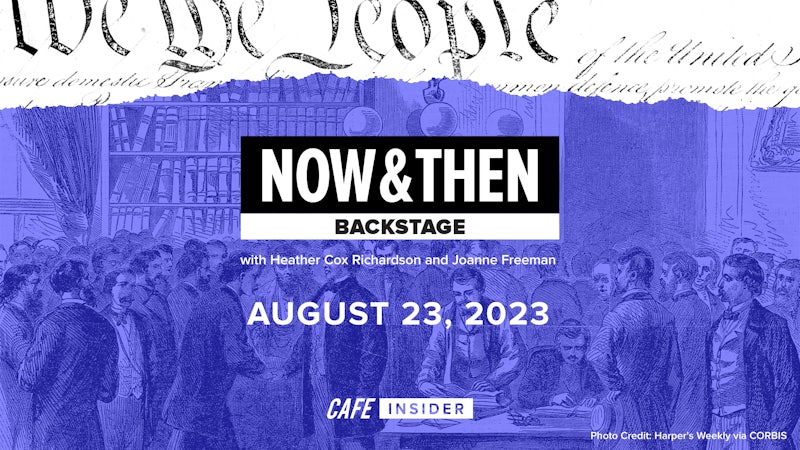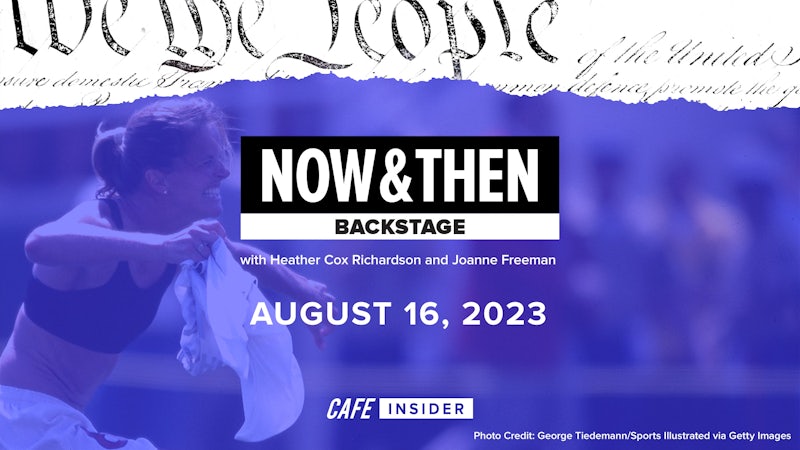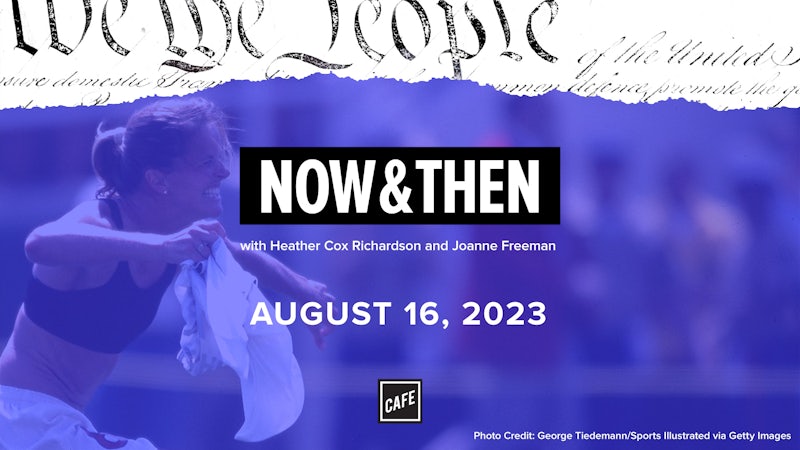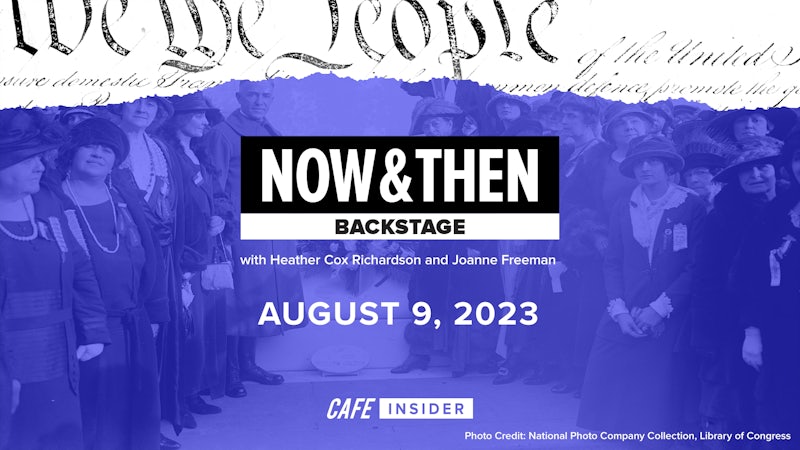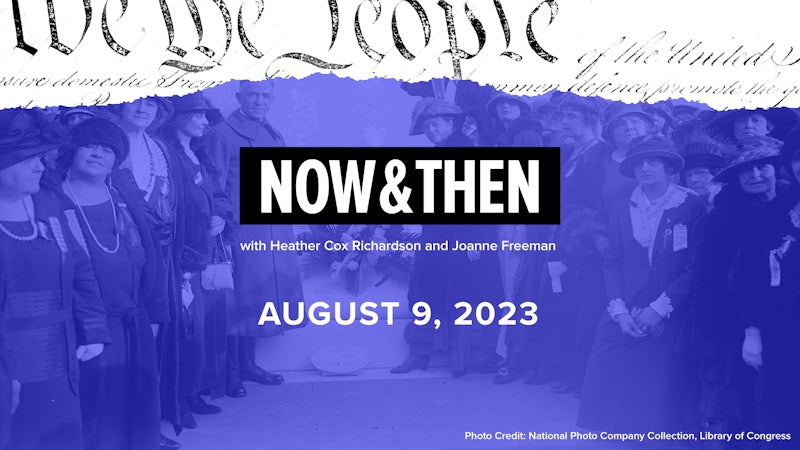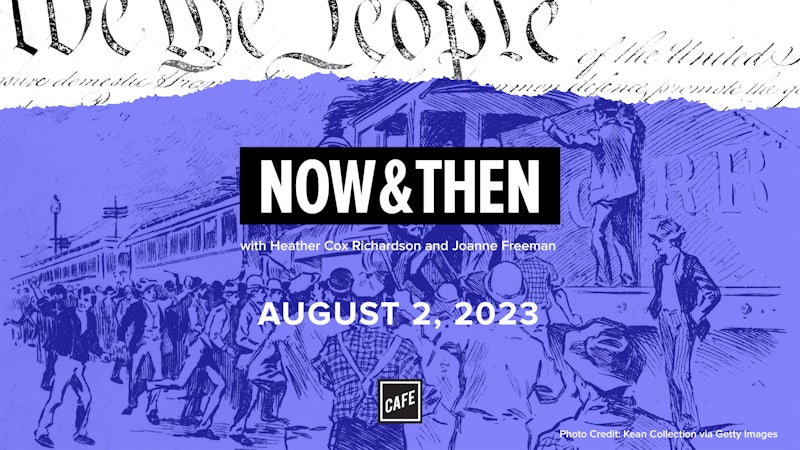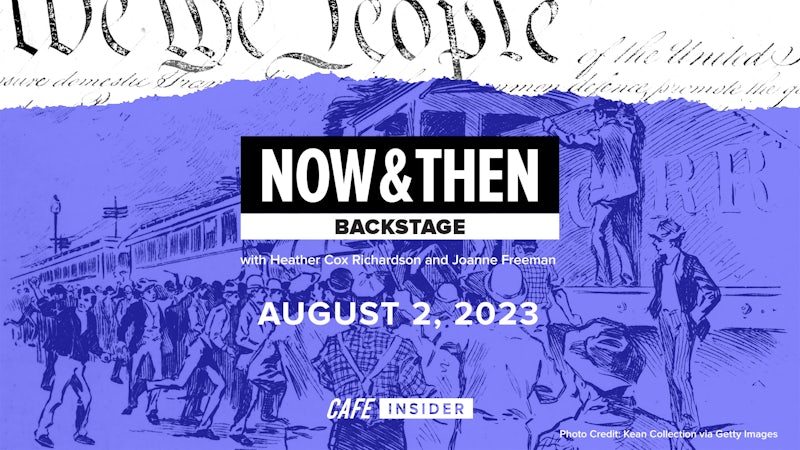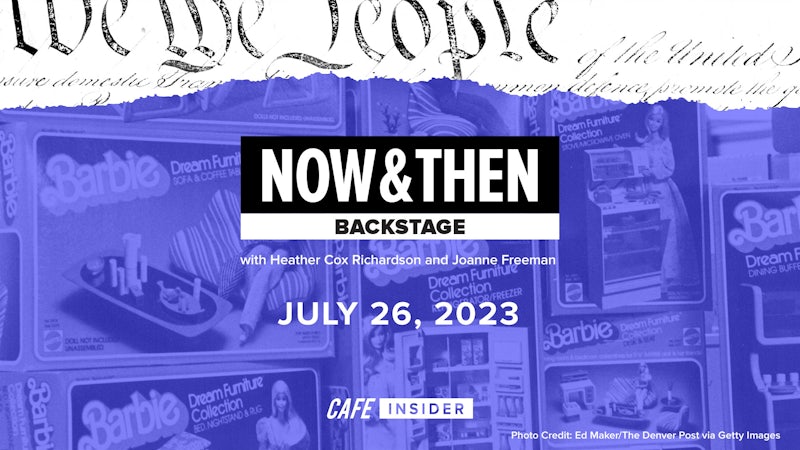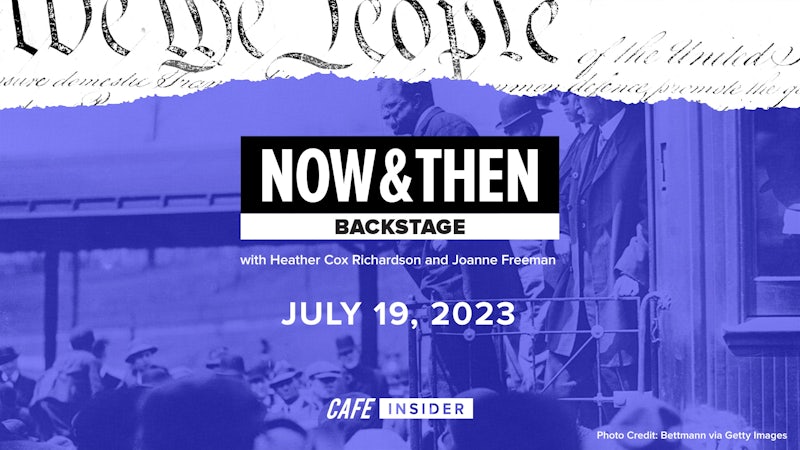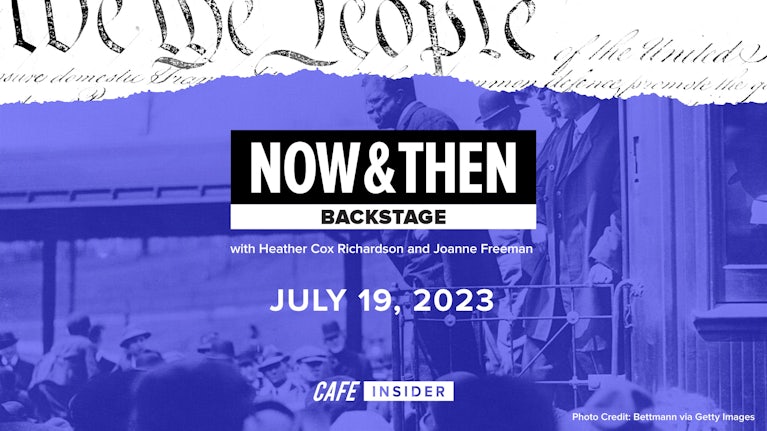Heather Cox Richardson:
From Cafe and the Vox Media Podcast Network. This is Now & Then. I’m Heather Cox Richardson.
Joanne Freeman:
And I’m Joanne Freeman. Today’s topic basically is hard for you to ignore if you’re almost anywhere in the United States, I would guess. What we want to talk about today is inspired by the much, much, much hyped movie, Barbie, the film, distributed by Warner Brothers, and it’s about Barbie the doll and Ken, and has some half serious, half sardonic plot. I will confess readily right here at the outset, I have not seen it. I do not know if I will see it. But, the whole idea of Barbie and Ken and what they represent to me is a fascinating one, and it says so much about the United States in any given moment of time. So what we want to talk about today is dolls of various sorts, and the larger messages that they do or don’t send. And, Barbie will be a part of this story. Barbie will not be the entire story.
Heather Cox Richardson:
One of the things that jumps out to me about this topic, actually two things. First of all, I feel like an intelligent Martian on this, because I never owned a Barbie. I never played with Barbies. In fact, I don’t even know very much about dolls. So, my approach to this is all very academic, if you will. And yet, studying dolls is enormously important, both because of what they say about our society, but also what they say about our consumer economy. Because, if you look at this film, I have not been able to miss the extraordinary marketing blitz. Mattel and Warner Brothers, which is distributing the film, have organized more than 100 brand collaborations to promote the film. So even somebody like me who reads almost exclusively in politics, I bet I’ve seen six ads a day. Microsoft has introduced a Barbie Xbox. The clothing store, Hot Topic, there are Barbie cardigans.
Joanne Freeman:
Oh, there’s Barbie everything. There’s Barbie cocktails. There’s Barbie core fashion. I mean, honestly…
Heather Cox Richardson:
Barbie electric toothbrushes.
Joanne Freeman:
At Ulta Beauty. Airbnb has put a pink mansion, which apparently was already pink, up on their home booking website, complete with a listing in the voice of Ken. The first group to book the house got to stay there on the night of the film’s premier. It’s very much about consumerism. But for that precise reason, it’s very much about our culture and its evolution over time.
Heather Cox Richardson:
So I guess it’s probably worth recognizing that dolls that start with a marketing scheme, or that are part of a big marketing scheme, are really largely a 20th century phenomenon in the United States. Not entirely, we certainly had tie-ins of dolls to Uncle Tom’s cabin, which was a book and a play from the 1850s.
But, until we get mass marketing, dolls really are homemade. Toys are homemade, but if we’re focusing on dolls, one of the ones that jumped out to me was when Laura Ingalls Wilder talks about the days in little house in the big woods of being a little girl. Her doll is a corncob that’s wrapped in a handkerchief. And, her sister, Mary, had a rag doll. And, the rag doll, Netty, Laura was incredibly jealous of. Her doll was, as I say, a corncob she called Susan. And there’s a moment when she gets finally her own ragdoll. And, we’re thinking here that this is going to be a homemade ragdoll, but to her, it is just such an extraordinary moment to have enough resources directed to her as a young girl in a family that’s very, very poor, that she would actually get a rag doll.
And she describes it. “They just looked with shining eyes at those lovely Christmas presents. But Laura was happiest of all. Laura had a rag doll. She was a beautiful doll. She had a face of white cloth with black button eyes. A black pencil had made her eyebrows, and her cheeks and her mouth were red with the ink made from poke berries. Her hair was black yarn that had been knit and raveled so that it was curly. She had little red flannel stockings and little black cloth gators for shoes, and her dress was pretty pink and blue calico. She was so beautiful that Laura could not say a word. She just held her tight and forgot everything else.”
Joanne Freeman:
But here’s what struck me about that very same anecdote, is that, until that magical moment, when Laura gets her very own doll, she did indeed have this corncob doll wrapped in a piece of cloth. And, Ingalls Wilder says regarding this, “Laura had only a corncob wrapped in a handkerchief. But it was a good doll. It was named Susan. It wasn’t Susan’s fault that she was only a corncob. Sometimes Mary let Laura hold Netty, but she did it only when Susan couldn’t see.” And, first of all, that made me laugh. But on the other hand, it also gave me pause, because Laura was identifying with the corncob doll, and didn’t want the doll to feel embarrassed or sad that it couldn’t rank up to the fancy doll that Mary had. Even before I began mussing about the topics of today’s episode and was beginning to just introduce myself to some of it, that little quote really struck me, and I felt it right. And it really drove home this idea that particularly girls in their dolls identify with them in all kinds of interesting ways that they don’t perceive.
Heather Cox Richardson:
Yeah. That’s a really important point. And, the other thing that we’re going to see in the 20th century is the degree to which having multiples of dolls, like Arby’s as we’re going to talk about, is part of a certain age of development where you learn to sort things. And that’s the other piece that comes up in the Laura Ingalls Wilder books is her mother does make paper dolls for the girls. And, they dress the dolls in different clothing that’s been cut out of wrapping paper, or that has been somehow altered so they can dress the dolls up. And that one really hit home, because there’ve been a lot of comparisons made of paper dolls, and barbies, and what they say about people at a certain age of development.
And I always love that, because in fact, I had paper dolls. I didn’t have Barbies or a rag doll. But, I have incredibly fond memories of playing with paper dolls, which felt even at the time as being very old-fashioned. But now that I recognize it’s the same aspects of development going on between, like you say the corncob, and then later on as we’re going to be talking about in the 1950s for example, the degree to which people identify with certain dolls.
Joanne Freeman:
In some cases what kids want to do with these toys. In the case of paper dolls, or in the case of Barbie, right? This doll, you want to dress them up, and try different dresses on, right?
Heather Cox Richardson:
But before we get to Barbie, we have to deal with the doll that still haunts my nightmares.
Joanne Freeman:
I had one of these dolls. But I can’t say I ever felt any remote feeling of affection for this. It was like, “Well, my grandparents got me this thing. I guess I’ll keep it.”
Heather Cox Richardson:
I don’t know why I’ve always had such a visceral dislike of these dolls, except that, again in a funny way, I think they were just in the house when I was growing up. And there were books about them, and now I know why. And they creeped me out so completely.
Joanne Freeman:
We’re going to be upsetting someone, Heather.
Heather Cox Richardson:
I still have nightmares about this.
Joanne Freeman:
I know, but we’re going to be upsetting some-
Heather Cox Richardson:
But they were beloved.
Joanne Freeman:
… They were beloved. And they sold and made oodles, and oodles, and oodles of money. We’re talking about Raggedy Ann. So, one interesting thing, before we get to the actual doll, let’s talk again about consumerism, right? That that really marks the beginning of real mass marketing of dolls. In 1915, Raggedy Ann became a early adopter of what we’re now seeing in full force with the Barbie movie, the mass merchandising. The creator of Raggedy Ann, and we can’t forget Raggedy Andy, the creator of both of them was John Gruelle, who was born in 1880 in Arcola, Illinois, raised in Indianapolis. His father actually was a famed impressionist painter. And Gruelle, I guess, in the same line of work, became a newspaper cartoonist in Indianapolis, eventually went to New York as a freelance artist. A Gruelle family friend, named James Whitcomb Riley was a famed Indianapolis based children’s poet. And he wrote two, apparently, very famous, iconic works that ended up shaping what became Raggedy Ann.
One of them was titled The Raggedy Man, and the other one was, Little Orphant Annie. Now, The Raggedy Man was an 1888 poem about a kindly man who worked on his father’s farm. And this comes from The Raggedy Man. “Oh, The Raggedy Man. He works for Paw. And he’s the goodest man ever you saw. He comes through our house every day and waters the horses and feeds him hay. And he opens the shed, and we all laugh when he drives out our little old wobbly calf.” Now, another work written a couple years before this titled, Little Orphant Annie, and it actually, there’s a T at the end of Orphant, which did inspire down the road, the comic strip and everything else. Mass merchandise in and of itself. And, there was a plucky servant girl at the heart of Little Orphant Annie, and this comes from that work.
Heather Cox Richardson:
I am so enjoying hearing you read these things.
Joanne Freeman:
I can tell. You’re making it very hard not to laugh, Heather, truly. It’s going to get worse. I promise you it’s going to worse.
Heather Cox Richardson:
See, this why I became a historian of the Early Republic, so you don’t have to do this. This is my era. And, listen, you’d be like, “She’s a plucky servant girl.”
Joanne Freeman:
Oh, I’m having beyond fun saying this, partly because of the impact on your face, I will say. Okay. “Little Orphant Annie’s come to our house to stay, and wash the cups, and saucers up, and brush the crumbs away, and shoo the chickens off the porch, and dust the hearth, and sweep, and make the fire, and bake the bread, and earn her bor and keep. Good old Little Orphant Annie.” So, Gruelle combines the farmland elements from The Raggedy Man with some of the raggedy, lower-class elements of Little Orphant Annie and creates this doll, Raggedy Ann, which he tests initially on his own children.
Heather Cox Richardson:
And this all makes a great deal of sense. The idea, first of all, of The Raggedy Man looking back to a happy bucolic existence, right at a time when people in the United States were largely very concerned about the rise of cities, and were fantasizing about what country life was actually like. And, the idea of, I’m sorry, but the happy servant girl in 1885. I’m sorry here… But yeah, yeah. But all the urban problems and rural urban stresses reworked in this very bucolic way that recalls girl’s father’s work as well, that luminous landscapes of the middle of the country, just at a time in the early 20th century when people are looking back on that period nostalgically, and overriding all of the tensions.
Joanne Freeman:
The fact that you just pointed out here, wee, it’s little servant girl, is that, the dolls aren’t being marketed to little servant girls, right? This is another thing to put in your mind when we’re talking about consumerism, and sales, and marketing. Think about who the dolls are being made for, and how that shapes what the doll is. And this is a great example of that, because middle class little girls are going to… Well, actually some of them, clearly not you or I. But, some little girls are going to be like, “Oh, look, it’s a little doll. Rag doll with raggedy clothes.” For some odd reason that I, Joanne Freeman, cannot understand, “Find it really cute and want to cuddle it.”
Heather Cox Richardson:
Well, and I always like to point it in this, who’s buying these suckers?
Joanne Freeman:
Oh, yes.
Heather Cox Richardson:
It’s not just the little girl, it’s their parents being like, “Oh, look, this is what America is supposed to look like.” But Gruelle was no fool. He applied for a patent on the rag doll and got a publishing contract to create a children’s book series starring Raggedy Ann. In 1918, he began to move the dolls toward the market and published the Raggedy Ann Stories. And maybe this is why it used to upset me. The central part of the stories was that the dolls and all the other toys came to life as soon as humans left the room, which certainly has come to life later on in Toy Story, which didn’t creep me out. But there’s another interesting tie in between Raggedy Ann and the rise of commercialized toys. And that is that, the final story in the Raggedy Ann Stories provided an explanation for why there were suddenly so many raggedy Ann dolls.
In the story, again remember, the toys come to life when there aren’t humans around. And in this final story, a toy maker named John takes Raggedy Ann from the girl who’s in the story. So, a girl named Marcella, and brings Raggedy Ann to a factory where she becomes mass-produced. And then, when she goes home or back to Marcella’s keeping, Raggedy Ann explains to her toy friends what had happened to her. And this is from 1918. And I will say, again, this is not an unusual trope in fiction literature in the early 20th century. So, the interplay of myth, and reality, and fiction is pretty mixed up in this period in a lot of ways. So here’s Raggedy Ann explaining how she went from being a ragdoll to being mass-produced.
“The next time I was taken from the bag, I was in a large, clean, bright room. And there were many, many workers all dressed in white aprons. John showed me to the people in aprons. Then they cut my seams and took out my cotton. And what do you think? They found my lovely candy heart. It had not melted at all as I thought. They put me on a clean white cloth on a table. Then they drew all around my body with a pencil. After that, they filled me with cotton again and dressed me. I stayed in that clean, big, and bright room for two or three days and nights. I watched my sisters grow from pieces of cloth into dolls just like myself.”
Joanne Freeman:
You actually created a Raggedy Ann voice.
Heather Cox Richardson:
But doesn’t that sound exactly how she should have spoken in that era?
Joanne Freeman:
I had no voice for Raggedy Ann.
Heather Cox Richardson:
That’s all right. I’ll let you do Barbie.
Joanne Freeman:
Yeah. Oh.
Heather Cox Richardson:
But that interlocking commercial system of both the toys, and the books, and the doll that in a sense comes to life is enormously successful. In the first eight months of production, they sell 3,200 dolls. It was so successful that in 1920, Gruelle introduced a companion for Raggedy Ann, named Raggedy Andy. By the time he died in 1938, Gruelle had written and illustrated more than 20 installments of the Raggedy Ann and Andy book series, and had syndicated those adventures in newspapers across the United States. And, it became well enough known, and so symbolic of the 1930s, think depression, here’s a happy servant girl.
Joanne Freeman:
Wearing rags.
Heather Cox Richardson:
Wearing rags, who lives and has all these connotations of the past and the rural experience. And in 1930, Gruelle wrote lyrics for a series of Raggedy Ann and Raggedy Andy records, which were set to music by the president of the Federal Reserve Bank of New York, who briefly served as FDR’s treasury secretary from 1933 until his death in 1934.
Joanne Freeman:
“You know what? In between my time as the secretary, I’m thinking. I got to say, Raggedy Ann and Andy to music because…”
Heather Cox Richardson:
The songs were sung by a man named Frank Luther, and they were collected as Raggedy Ann’s Sunny Songs. Again, depression, say happy, but raggedy. The songs really, again, stressed that old world that the doll seemed to have come from, even suggesting that Raggedy Ann was literally from a simpler past, and had been discovered in a grandmother’s attic.
Joanne Freeman:
Here is my raggedy Ann 1930s.
Frank Luther (archival):
My Raggedy Ann is a very old doll / She lay in the attic for years / She lived in a trunk there for fifty long years / With her legs doubled over her ears / And that’s where I found her, my Raggedy Ann / And grandmother gave her to me / So I love every wrinkle in Raggedy Ann / And that’s why she’s smiling at me.
Joanne Freeman:
Boy, that just captures it all right there. The nostalgia, “It’s from my grandmother, it was waiting in the attic, and now it’s been given to me, and she’s smiling, and I love her.” There’s just this warm embrace of nostalgia linked with that. But somehow, you and I entirely escaped Heather, but linked with that doll.
Heather Cox Richardson:
Well, the nostalgia and what it says about people at the time. The nostalgia that’s being marketed. I mean, the marketed nostalgia and the aspiration in this period of a simpler world, the idea that somehow you could get away from the troubles around you in 1930 by reaching to an old past that involved this rural/servant girl/ragdoll from the past. It’s a really interesting bridge of Laura Ingalls Wilder and our understanding that we’re going to have within 20 years of the importance of all those factors.
All right, so we took a look at Raggedy Ann and what she with her servant girl connotations might have meant at the time. And, that’s 1915 to 1930 or so. One of the things that people who study children are going to figure out in the middle of the 20th century is this link between marketed toys, marketed for a certain audience, and what that does to the way children identify themselves. Really, really important story in the 1940s.
Joanne Freeman:
And how it shows how they identify themselves.
Heather Cox Richardson:
That’s right.
Joanne Freeman:
What it does to that and how it reveals that in a blatant, and in this case, really stunning way.
Heather Cox Richardson:
So in the 1940s, a couple of black New York psychologists named Kenneth and Mammie Clark designed what’s called the doll test to show what segregation meant for children, and what it did to the self-esteem of black children. The Clarks painted a white doll brown, because at the time, there were very few black dolls on the market, and they asked 253 black children from ages three to seven to play with the black dolls as well as with white dolls. Then, the Clarks asked the children, which dolls they preferred, and which dolls matched their own skin color. Strikingly, the majority of the children assigned positive traits to the white dolls and were uncomfortable with identifying themselves with the Black dolls.
Joanne Freeman:
Psychologist, Kenneth Clark, in 1985 put very bluntly what was so striking and painful about that study.
Dr. Kenneth Clark (archival):
The results of our studies were indicative of a dehumanizing, cruel impact of racism in a allegedly democratic society. These children were internalizing, they were seeing themselves in terms of the society’s definition of their inferior status. That’s not a pretty thing to… And, it was hard for us to pretend to be objective about it.
Heather Cox Richardson:
So that doll test soon became incorporated into the litigation over desegregation. So, Kenneth Clark testified in the Briggs versus Elliot District Court case in 1952, which was designed to desegregate public schools in South Carolina. And the Briggs case then became one of the five cases that were wrapped together into the 1954 Supreme Court case of Brown vs. Board of Education of Topeka, Kansas, in which, the court ruled that segregated public schooling was unconstitutional, and ordered public schools to desegregate with all deliberate speed.
The Chief Justice Earl Warren, a Republican by the way, former Republican governor of California, was moved by the doll tests, and he implicitly referenced the tests when he wrote the majority opinion for Brown. He said, “To separate black children from others of similar age and qualifications solely because of their race generates a feeling of inferiority as to their status in the community that may affect their hearts and minds in a way unlikely ever to be undone.” Really interesting. And you think about the echoes of that line from Warren, and what it means to discriminate at a state level against certain people. Much of what’s comes out of the study of dolls.
Joanne Freeman:
Interesting, and highlights what we’ve already been pointing to and we’ll continue to point to throughout the episode, which is, just as you just suggested Heather, we’re looking at dolls, we’re looking at culture, but what that reveals, and the depth of that, the profoundness of that, the meaning of that goes very, very deep. And this actually does bring us to Barbie. So, by the end of the 1950s, that’s the period when what we now recognize as the Barbie doll came to be. Barbie was the brainchild of a businesswoman named, Ruth Handler, who was from a Polish Jewish family in Denver, moved to Los Angeles as a young woman, and with her husband founded a toy furniture company Mattel in 1945.
Now, handler was inspired to create Barbie based on a trip that she and her family took to West Germany in the mid-1950s. In Germany, she came across a doll called the Build Lily. It was a German doll. It was based on an escort character from a rather racy comic strip. It tended to be given as a gag gift. I thought of the sorts of things that sometimes you see hanging from rear-view mirrors, right? The racy, way exaggerated image of the beyond stereotypical woman that’s meant to be ogled. But Handler thought that the basic appearance of that plastic doll might be able to be a hit in the United States.
In a 1979 New York Times interview, she even suggested that the sexualization of the doll partly was mixed in with her calculus. She said, “Every little girl needed a doll through which to project herself into her dream of her future. If she was going to do role playing of what she would be like when she was 16 or 17, it was a little stupid to play with a doll that had a flat chest. So I gave it beautiful breasts.” Okay. Now, on returning to the United States, Handler, not surprisingly, created a doll based on the Build Lilly and it first went on the market in 1959 and was billed as a teenage fashion model. She was wearing a zebra striped swimsuit. Apparently she retailed for $3, and you could get her with either blonde or brunette hair. And, now we move into the realm here where there are all kinds of ads.
Heather Cox Richardson:
I do want to point out before we get into the advertising for Barbie and everything that went around with it is how important this moment was in the United States history, because of the Cold War, and because of the gender roles that came out of the Cold War. So one of the things that people who are concerned about American politics in the 1950s really push is what they consider the differences between the Soviet Union’s communism, and the gender roles in the United States. So one of the things that people who are concerned about politics in the United States keep pushing is the idea that people in the Soviet Union are sexless. That is, that the men and the women are all the same thing. You can’t tell the difference, they all are wearing potato sack clothes. And, that translates in the United States to the idea that there are boys and girls, and that the true goal of girls especially is to look very feminine, as it’s defined at the time. There’s all the ads, for example, of women vacuuming their homes in high heels, and dresses, and pearls.
Joanne Freeman:
Frilly little aprons.
Heather Cox Richardson:
Frilly little aprons. And my thing is the poodle dress, the poodle skirt. That girls are girls and boys are boys. And, the best thing that a woman can possibly conceive of, is to grow up to be, in this case, a teenage fashion model. I mean, the idea of these hyper-feminized dolls fits really in the larger Cold War story.
Joanne Freeman:
There’s a flip side to that too though, because at the same time that Barbie is this figure that represents an ideal, as opposed to how Americans are envisioning what’s happening across the world during the Cold War. At a very early point, I mean, even just teenage fashion model, Barbie has a career, she has a job, you’re not putting Barbie in the kitchen. She was seen as having a college degree. Again, at a very early point, she’s given different careers. She’s not particularly married. She’s not a mother.
Heather Cox Richardson:
She’s not particularly married.
Joanne Freeman:
Well, I mean, if you want to make her married to Ken, you could, I suppose. I never owned a Ken, but she’s not meant to be married, but she could be if you want her to. But the point is that, even as Barbie can symbolize this feminine ideal that is countered to what people are seeing in Russia, it’s also countering Russia in the sense that women can be ambitious, and women can achieve things. And somehow, both of those things could be true at the same time. And they were with the Barbie doll, from a very early point. It’s part of the reason why there has always been and continues to be such conflict over the Barbie doll, because on the one hand, it seems like the most sexist… Or at least the early dolls, sexist male-view based consumerism, ultra-feminine version of a woman that no girl should feel compelled to be. And on the other hand, Barbie was an astronaut. Barbie was a person who ran a company. Barbie was a newspaper editor. And, those could be seen as aspirational too.
And I think, some of what we’re seeing even now… I think this has always been the case, but even now, in my rummaging around online to see how people were talking about the Barbie movie now, that argument is still taking place. People hating the movie because it seems to be, once again, delving into these tropes, people liking the movie because it seems to be smacking back at those tropes, people not being sure what to think of the movie. And that says so much about dolls generally, but the Barbie doll specifically.
Heather Cox Richardson:
This is the first Barbie ad.
Barbie Ad (archival):
Barbie you’re beautiful / You make me feel my Barbie is really real / Barbie’s small and so petite / Her clothes and figure looks so neat / Her dancing outfit rings some bells / At parties she will cast a spell.
Heather Cox Richardson:
That’s from 1959.
Joanne Freeman:
I’m not denouncing the, “Ain’t she pretty?” That Barbie. People love her at parties. The boys want to ask her to the prom component of this. It’s just a layered meaning attached to the doll.
Heather Cox Richardson:
So, Mattel introduces Ken in 1961. And, by that point, there were in fact clothing add-ons onto the dolls to give children the idea they could have career opportunities that could be incorporated into those fantasies.
Joanne Freeman:
So if you think about American feminism generally, people tend to talk about feminism as being in waves. And the first wave people attribute really to women voting. And that late-19th, early-20th century moment. The second wave of feminism, people tend to peg in the 1960s, 1970s. That’s the period when Betty Friedan writes The Feminine Mystique, which argues that women are chafing against the confines of their roles as wives and mothers. And that’s a huge bestseller. That’s when you have Civil Rights Movement obviously booming. You have protest against the Vietnam War. And in that same line of inspiration, second wave feminists want a reevaluation of traditional gender roles in society, right? That’s part of what they’re demanding, in addition to more concrete legislative things like equal pay.
But so what happens in this time period is you have people complaining about the frilly apron, poodle skirt, Barbie. And, in the 1970s, there begin to be complaints about that Barbie being so prevalent. And, the Handlers who created Barbie in the first place said, “Oh, no, no, no Barbie, she’s going to move with the times.” And so, they then created Barbies with careers. Although interestingly, at an early point, when someone suggested to the Handlers that there should be a doctor Barbie. Handler replied, “When there are enough women doctors around, then Barbie will have a doctor outfit. When American girls go up in space, then we’ll have a girl space doll.” So the question of how much these things are inspiring, and how much they’re reacting, and both of those things obviously have so much to do with basic commerce and who’s going to buy them, is interesting. But second wave feminism was very much inspiring the direction of how Barbie was going as a toy. And of course, that was for reasons of making Barbie popular and selling Barbie dolls.
Heather Cox Richardson:
But there’s such a crucial interplay between the moneymaking aspect of toys and dolls in this case and society, as in, are they reacting to society, or are they trying to change society by inspiring other children? The idea that it’s not until 1968 that we get a black doll that is in the Barbie family, but it’s not a black Barbie, it’s a black friend of Barbie, named Christie. And, the reinforcing of a certain white norm with Barbies in particular, but with a lot of dolls, these are private enterprises. They don’t want to create things that don’t make money. At the same time, they are reinforcing stereotypes that become enormously pervasive.
Joanne Freeman:
They’re creating and eliminating possibilities and opportunities with that definition. Barbie is white. Barbie’s friends can be different, but Barbie is white. And, again, that gets back to the baby doll experiment we talked about earlier. Kids are identifying with the dolls, they’re thinking about themselves in relation to those dolls. And, that has an impact on children, on adults, and on society. I mean, it’s striking that it wasn’t until 1980 that you had the first Barbie dolls named Barbie who were black, not just dolls who were friends with Barbie.
Heather Cox Richardson:
And then, in 1985, interestingly enough, when we’ve got the corporate boom of the 1980s, there’s a Barbie that hits the market who’s a CEO. And Day to Night Barbie wore a pink pant suit that doubled as both office attire and a party outfit as well.
Joanne Freeman:
So, along the lines of what we’re talking about here in the 1980s, and particularly in 1985, you get a very explicitly feminist ad campaign for Barbie. An ad campaign with a song that sings…
Barbie Ad (archival):
We girls can do anything? Right Barbie? / And we girls can dream anything / like Barbie / We can be whatever we want / Aim just as high as the sky / Anything is possible as long as we try! / We love working from 9-5 / But when the day is done we girls deserve some fun!
Joanne Freeman:
Wow.
Heather Cox Richardson:
That again, it’s a wonderful tie-in to both the history of the time and the commercialism of the time, in that, think about this is the period… Not exactly the day I don’t think, but the period we’re going to get Madonna and Material Girl.
Joanne Freeman:
Right. I just had to grimace because we love working from nine to five is just hard to say. But no, you’re absolutely right. It is the essence of that particular moment. It’s also interesting that… I don’t know, it’s weird that the ad is talking to Barbie, right? “We girls could do anything, right Barbie?” Now, what we haven’t talked about up until this point is G.I. Joe, a flip side of the rise of dolls happening roughly in the same time period as the rise of Barbie. And I want to start out by saying one thing, because we automatically, in talking about this episode, began referring to G.I. Joe and other such dolls as action figures. They’re dolls, but we don’t call them dolls. And as a matter of fact, the president of Hasbro, a man named Merrill Hassenfeld when G.I. Joe first went out into the world said, “Don’t you dare call G.I. Joe a doll. Heaven forbid, G.I. Joe is an action figure.”
And, from the very beginning, G.I. Joe was different in many ways from Barbie beyond the obvious. G.I. Joe was muscular. G.I. Joe could move arms, and legs, and things. Barbie, you could move her at her waist, and after a while you could click, click, click, click, click, click her legs and her arms. Yeah. But, G.I. Joe could move around. And there was no question initially about G.I. Joe’s career. He was a soldier. So the figure launches in 1964. And, at the time, Hasbro’s big toy products were colored by number sets and Mr. Potato Head.
The original G.I. Joe concept, a 12-inch military figure for boys, was created by a toy designer named Stan Weston. And Hasbro initially turned it down. But there was an executive there named Don Levine who recognized that you could use that G.I. Joe concept to create a realistic male, I’m going to say it, doll, that would appeal to young boys. Levine said, “Suddenly it occurred to me, that we could create something truly magnificent if there was a way to produce figures that moved and posed any which way the human body did. (Unlike Barbie). Tin and plastic soldiers have been favorites of children as long as there have been toys. It seemed to me that this fully articulated man could be a giant step forward.”
Heather Cox Richardson:
Now, one of the things that I really like about G.I. Joe as a toy figure is that G.I. Joe got its name and personality from a film from 1945 about Ernie Pyle. Ernie Pyle was one of the most famous war correspondents and just a great writer and a fascinating man. But what interests me about that is the film comes out in ’45 and the first G.I. Joe hits the market in ’64, almost exactly 19, 20 years later. And, the degree to which G.I. Joe then, becomes in a sense, a period of nostalgia for the heroism of World War II, right then in the 1960s, I think, really leaps out. That 20 year gap, it’s like, “Oh, remember Ernie Pyle? Remember the heroes of World War II?”
Joanne Freeman:
Of course, part of why that’s happening, the Vietnam War, because now you have a military moment that is not like that earlier moment at all. And so, some people are looking back to this glorious moment of the past, and not surprisingly, the controversy surrounding the Vietnam War cuts into the profits for G.I. Joe. And people, again, we’re talking about the parents, begin turning against the idea of a war centric doll very explicitly tying it to the Vietnam War, saying that it glorifies war, it’s creating an unrealistic expectation of what combat looks like, and is glorifying something that people are not particularly enthralled with at that moment. The nature of the war, the war itself, the fact that it’s continuing.
Heather Cox Richardson:
But there’s a really interesting change at that point, when those opposed to the Vietnam War begin to complain about G.I. Joe. Hasbro, which has made great profits from G.I. Joe, expands G.I. Joe’s backstory and his skills, so that by the middle of the 1970s he’s an adventurer. And pretty soon he’s going to turn into a special ops team. The idea that the toys are going to usher in a new way of thinking about society in terms of its military, but also what that does for the way people think about individuals. No longer are you supposed to be a G.I. Joe who works with your unit. Now, you can be this member of a special ops team that operates outside the law and takes on all these exciting roles that don’t reflect community. I just think, that shift is fascinating.
Joanne Freeman:
Now, when we were first talking about this episode and we talked about Barbie and what else should we add, and I thought, G.I. Joe. And the first thing that came out of my mouth was with Kung Fu Grip, and that’s because my brothers had G.I. Joe with Kung Fu Grip.
Heather Cox Richardson:
And I totally thought you were so sick you were hallucinating.
Joanne Freeman:
It’s just terrifying to me that from… Let’s see, how many decades is it that that’s still in my brain? Too many. So in 1974, Hasbro cashes in on the Kung Fu craze, which is, popularized by Bruce Lee, and there’s a very popular TV show with David Carradine starring in it named, Kung Fu. So now, G.I. Joe has the more malleable plastic, and you can bend his hands into a kung fu grip, meaning basically he can now hold weapons more than he could before. I’m sure he can also do kung fu moves. But basically now, his hands are really malleable. And, here’s what the 1974 ad sounded like.
G.I. Joe Ad (archival):
And here is G.I. Joe with Kung Fu Grip. G.I. Joe has hands that grip. Fingers you hold open and let close. Hands that hold on with a kung-fu grip. The grip you help Joe use in self-defense.
Joanne Freeman:
Because of course, it’s only in self-defense. I love the fact that they throw that into the end. “But you’re not being violent, you’re only defending yourself. But here, have kung fu grip.” That obviously becomes famous and popular. It is happening around the same time as other dolls/action figures like the $6 Million Man. So now, there are dolls for boys, which in one way or another, are emphasizing both what boys might want to be and what their parents would like them to be.
Now, what’s interesting to me is that, along with the dolls and along with the strong ideas that go along with them, there have also been protest organizations associated with the dolls. So for example, in 1993, there was a group that called itself the Barbie Liberation Organization. And apparently, what the Barbie Liberation Organization did was they bought several hundred Barbies and G.I. Joes that talk, teen talk Barbies and talking G.I. Joe electronic battle command. And, they switched their voice boxes. So now, when you brush Barbie’s hair, the doll would say, “Eat lead Cobra.” So they were making a point.
In Germany, in 2013, there was a mobile… Not quite a park, but it was called an experience, right? That was supposed to travel from city to city, called the Barbie Dream House Experience. And, it was a huge Barbie Dream House, covered 25,000 square feet. And, they were expecting masses of people to go, and walk through it, and there was a little kitchen, where you could make virtual cake. I don’t know what it was you were doing in the Barbie Dream House. But, the reason I mentioned this is not because of that in and of itself, which is fascinating, but it’s because a movement grew called Occupy Barbie Dream House. And, Occupy Barbie Dream House was very upset with the fact that this seemingly sexist, seemingly commercial monstrosity, and if you look it up online, you’ll see how very, very pink it is, appears first in Berlin, they protested and apparently even put Barbie dolls up on a cross. They crucified Barbie.
My larger point here is just that, everything that evolves about these dolls, how people think of them, how they want to think of them, how they’re being marketed or not being marketed, what people think of them, protest organizations, particularly in the more modern era, growing up around them. All of that is of a piece which brings us back to the current Barbie moment.
Now, apparently there is a phenomenon blossoming on TikTok right now that has far deeper roots. But it goes under the label Bimbo feminism. And the idea behind it is that basically women are claiming that they can present themselves as hyper feminine, anything you can imagine that is hyper feminine: high heeled shoes, form fitting clothing. In essence, they have control of their bodies and they have control of how they want to present their bodies to the world. Now, it’s fascinating in essence, this is reclaiming the word Bimbo and giving to it a kind of empowered usage. And what’s striking about this whole movement is that unlike feminists of maybe a generation back who didn’t really prefer to label themselves Bimbo feminists, these feminists are calling themselves feminists in a really declaratory way. It’s a fascinating phenomenon and it makes sense that it’s having a blossoming moment right now, given the moment we’re in and the ongoing conflict over women’s bodies and who control them.
And so, what’s one of the things that’s fascinating to me is just this idea that some of what we’re watching brew here, not just in the creation of a Barbie movie, and the response to it, or the impact that it’s going to have, but that in this sense, it makes sense being born in this moment in ways that have bubbled throughout many of our episodes on Now & Then, women are addressing, and renegotiating, and trying to understand their place in society as it is now, where they’re being given some pretty strong messages about who we are and who we can and can’t be. Makes perfect sense that in this moment, you might have a new wave of feminism that is about taking control of your body, asserting femininity. This is information. I can’t say anything definitive about it, but in ways that my historian brain is very happy with. It’s fascinating to consider what this Barbie movie says about us, and even more interestingly, in 20 years, what it’s really going to suggest about where we were at this moment and where we might go.












